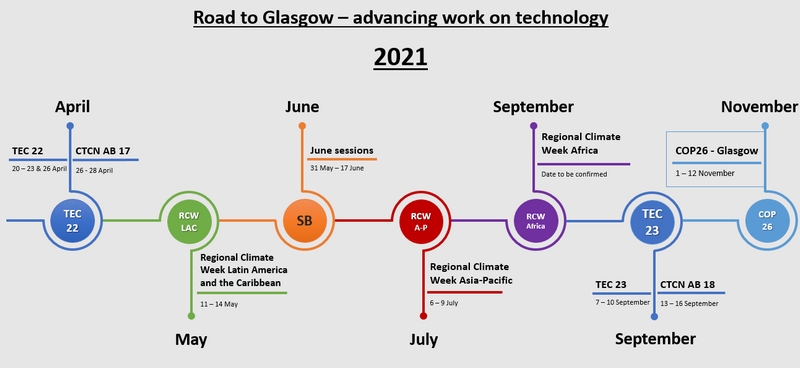Negotiations
Information on climate technology negotiations
Road to Glasgow – Technology Development and Transfer
Agreed by countries in Paris in 2015, the ground-breaking Paris Agreement paves the way for a new chapter in global action on climate change. It also sets the stage for urgently needed climate technology development and transfer. Notably, countries anchored the Technology Mechanism within the Paris Agreement and decided that it would be a key element in implementing the Agreement. They also strengthened the Technology Mechanism, requesting further work on technology research, development and demonstration, as well as on endogenous capacities and technologies. Additionally, the Paris Agreement established a technology framework to provide overarching guidance to the Technology Mechanism. Together, the Technology Mechanism and the technology framework support countries to limit the rise in global temperature and adapt to climate change.
As the COVID-19 crisis continues to demand the efforts of governments and other stakeholders to ensure people’s health and well-being, the urgency of addressing climate change remains. Despite challenges and uncertainties in 2020, momentum in the UNFCCC process has been maintained. In 2021, the UNFCCC will continue its efforts to advance the work on technology-related matters at the June sessions and at COP 26 in Glasgow.

Hover and click on the events to learn more
The Road to Glasgow is paved with several meetings and events to advance the work on technology, such as the meetings of the Technology Executive Committee (TEC) and the Advisory Board of the Climate Technology Center and Network (CTCN) and the regional Climate Weeks. Of special importance are the June sessions, which will lay the groundwork for the negotiations at COP 26 in Glasgow.
In the UNFCCC process, governments periodically meet to explore how to enhance climate technology development and transfer. The UNFCCC negotiations provide a political forum through which all countries may openly communicate their interests and challenges regarding enhancing climate technology action. The table below lists the current climate technology related issues in the UNFCCC negotiation process.
Issue | Mandate | Original Session |
Subsidiary Body for Implementation (SBI) and Subsidiary Body for Scientific and Technological Advice (SBSTA) | ||
Joint annual report of the Technology Executive Committee and the Climate Technology Centre and Network (2020 and 2021) | SB 53 | |
SBI | ||
SBI 52 | ||
SBI 52 | ||
SBI 53 | ||
Linkages between the Technology Mechanism and the Financial Mechanism of the Convention | SBI 53 | |
COP 26 | ||
COP 26 | ||
Linkages between the Technology Mechanism and the Financial Mechanism of the Convention | COP 26 | |
Review of the constitution of the Advisory Board of the CTCN | COP 26 | |
Second independent review of the effective implementation of the CTCN | Decision 2/CP.17, Annex VII, para. 20 | COP 26 |
CMA 3 | ||
CMA 3 | ||
Alignment between processes pertaining to the review of the Climate Technology Centre and Network and the periodic assessment referred to in paragraph 69 of decision 1/CP.21 | CMA 3 | |
First periodic assessment referred to in paragraph 69 of decision 1/CP.21 | CMA 3 | |
Since its creation, the TEC has become a key climate technology policy body under the UNFCCC. It analyses contemporary climate technology issues and develops balanced policy recommendations for countries to consider. It has tackled issues such as: climate technology financing; enabling environments and barriers; innovation; mitigation and adaptation technologies; technology needs; and technology research, development and demonstration. The TEC also serves the Paris Agreement by implementing the technology framework in collaboration with the CTCN. In 2021, the TEC will hold its 22nd and 23rd meeting, representing important milestones on the road to Glasgow. The list below provides an overview of planned activities by the TEC in 2021.
Area of work | Planned activities in 2021 |
Innovation |
For the outcomes, please click here. |
Implementation |
For the outcomes, please click here. |
Enabling environment and capacity-building |
For the outcomes, please click here. |
Support |
For the outcomes, please click here. |
Joint activities of the TEC and the CTCN | In response to decision 8/CMA.2, para. 3, the TEC and CTCN agreed on activities to be undertaken jointly in the period of 2021–2022 on two topics: Technology and NDC, and Gender and technology. As these two areas contain components that cut across different key themes of the current workplan, separate entries for the two joint activities have been added into the table. For the outcomes, please click here. |
TEC input to Global Stocktake | In response to decision 19/CMA.1, paragraph 24 whereby CMA invited constituted bodies to provide synthesis reports on the information relevant to their areas of expertise, as an input to the technical phase of the global stocktake process, the TEC at TEC21 agreed to discuss the preparation of its inputs in 2021. Similar to the joint activities of the TEC and the CTCN, this new activity contains components that cut across different key themes of the current workplan, therefore a separate entry has been added into the table. For the outcomes, please click here. |
Gender consideration | The TEC agreed to apply the general approach, as contained in document TEC/2019/19/10, to integrating gender consideration in the implementation of the activities of the rolling workplan to enhance the effectiveness and inclusiveness of the TEC recommendations. Further, the TEC established the role of Gender Focal Point within the TEC as described in the same document. For the outcomes, please click here. |
Monitoring and evaluation | In response to decision 13/CP.24 and paragraph 24 and 25 of the Annex to the decision 15/CMA.1, the TEC developed a monitoring and evaluation system to monitor and evaluate impacts of the activities under this rolling workplan. The system was developed in collaboration with the CTCN to ensure coherence of approach within the Technology Mechanism. The TEC will regularly review the implementation of this system, and revise it as needed. For the outcomes, please click here. |
Technology needs assessments (TNAs) are a set of activities that developing countries undertake to identify their climate technology priorities. Since 1999, more than 85 developing countries have assessed their technology needs to address climate change. Through the TNA process, developing countries identify technological means to address climate change and accelerate national development, build national capacity to support national sustainable development and create technology action plans to achieve implementation and demonstrate technology viability. Support to developing countries to undertake TNAs has been provided by the GEF, UNDP, UNEP, UNEP DTU Partnership and the GCF through the CTCN.
The list below provides an overview of TNA related activities planned in 2021.
Activity | Mandate | Description |
Compilation and synthesis of technology needs | The UNFCCC secretariat prepared the Fourth synthesis report on technology needs identified by Parties not included in Annex I to the Convention, mandated for consideration by Parties at SBI 52. The report synthesizes information contained in the TNA reports, barrier analysis and enabling framework reports, and technology action plan reports of 53 non-Annex I Parties that participated in phases I (2009–2013) and II (2014–2017) of the global TNA project. | |
Tracking the implementation of technology action plans | Tracking the implementation of technology action plans (TAP) is an important element of the TNA process, as reflected in the Guidance for Preparing a Technology Action Plan. Such tracking aims to increase the exchange of knowledge and experience sharing between countries and to enhance national and international awareness of the potential of TNAs and TAPs to upscale technology transfer. | |
Promoting success stories | The secretariat provides regular updates on progress of the implementation of the results of technology needs identified in TNAs, including success stories. These success stories will be promoted through various means, including the Regional Climate Weeks for Latin America and the Caribbean (held in May), Africa (held in July) and Asia-Pacific (held in July). |
